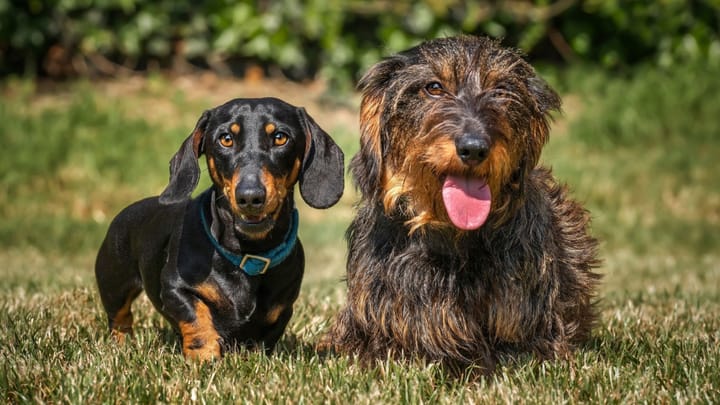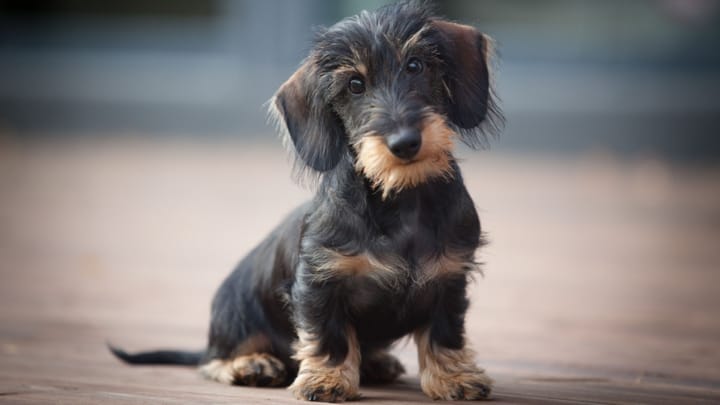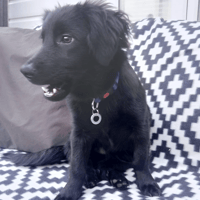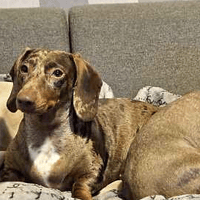Dachshund
Other names : Dackel, Teckel, Weenie, Sausage Dog


The Dachshund is a small terrier with a unique body type. With short legs and an elongated body, they resemble a sausage. They are determined, intelligent, courageous, lively and very jovial. They adapt to many ways of life, but they do need physical and mental stimulation to stay happy and healthy. They are well-tempered dogs who, if well trained and socialised, are a delight to have around. They come in two sizes: Standard and Miniature, and in three different coat types: Smooth, Long, and Wire-haired.
|
Life expectancy |
The Dachshund has a life expectancy of between 12 and 14 years |
|
Temperament |
|
|
Size |
Small
|
|
Adult size |
Female
Between 7 and 10 in
Male
Between 7 and 10 in
|
|
Adult weight |
Female
Between 7 and 20 lb
Male
Between 7 and 20 lb
|
|
Coat colour
Smooth-haired Dachshunds can be unicolour (red, yellow-red, yellow, with or without black spots), two-coloured (dark black or brown with red marks), or Harlequin (stripes or brindle). Wire-haired Dachshunds mostly have a wild boar-coloured coat, a more or less "dead leaf" colour depending on brightness. Long-haired Dachshunds are very often unicolour (from red to yellow) but they can also be two-coloured (shades of black, brown, and flame-orange) or Harlequin (dark coat with grey or beige marks). |
Black Brown Red |
|
Type of coat
There are several varieties of hair: Smooth, long and wire.
|
Short Long Hard |
|
Eye colour
Depending on the colour of the coat, the eyes can range from dark-brown to black-brown. In Harlequin subjects, odd-eyes are tolerated without being sought after. |
Brown
|
|
Purchase price |
The Dachshund costs between £1200 and £2000 |
Did you know the Dachshund was the first mascot of the Olympics? Indeed, during the Games in Munich in 1972, the organisers chose this athletic and courageous dog to be the face of the games.
Another unusual fact: The term "hot dog" may have been inspired by this sausage-shaped dog. Nothing is proven but many historians agree that in earlier times the hot dog was known as the Dachshund sausage.
Finally, this dog was the first pet cloned in England. Winnie, a 12-year-old dog, has been cloned by experts from South Korea and has shared her last few years alongside Mini-Winnie.
More details about the Dachshund
Dachshund: Origins and history
At the origin of this breed and other similar breeds, selection was made according to hunting ability. It is likely that the usefulness of the Dachshund in the hunt was discovered at the same time in different parts of the world. The Dachshund is considered to be a recent breed dating from the 18th-19th century: His ancestor is the German Basset, his close cousin, in addition to the Pinscher, who also made it possible to specify the size of the dog that we know today. His more recent history begins in Germany and more precisely in Bavaria, where the first Dachshund farms were created. In England too, the Dachshund is bred with a lot of passion, either as a hunting dog or as a pet dog, (but with a different ‘standard’). In addition, the two varieties (Standard and Miniature) are distinguished by their size differences. The Miniature version is newer. Concerning the sub-varieties of coat: the Smooth-haired is the oldest, followed by the Long-haired created in the 16th century when it was crossed with Cocker Spaniels. Finally, the Wire-haired version, created at the end of the 19th century, was the fruit of crosses between the Smooth-haired and the Schnauzer, the Dandie Dinmont Terrier and probably the Scottish Terrier.
Physical characteristics of the Dachshund
A dog with an elongated body, short legs, compact, vigorous and of good musculature. The head is graceful, with a rather flat skull and a buoyant posture. There are two sizes: Standard and Miniature, which are in turn divided into sub-varieties of coat (long, smooth and wire).
FCI classification of the Dachshund
-
Group 4 - Dachshunds
Dachshund: Varieties
- Dwarf dachshund
- Miniature Dachshund
Dachshund: Characteristics
Dachshund: Behaviour
Training a Dachshund
This small hunting dog has a thick head, and is not easy to educate - especially if he fails to perceive any sense or logic in the exercises requested of him.
Education must be started early. It needs to integrate firmness and coherence. Despite his small size, you must not show any weakness to this dog since he will exploit the slightest hesitance.
However, his intelligence, enthusiasm and playful side will make it possible to work together effectively, especially if the educational methods are adapted to his type and they favour the positive reinforcement of good behaviour.
Dachshund: Lifestyle
Breed compatibility Dachshund
Dachshund: Purchase price
The price of a Dachshund varies depending on its origins, age and gender. An average of £1,200 to £2,000 is required for a dog registered with the KC.
Regarding the monthly budget, it takes between £20 and £30 to meet the physiological needs of this small dog.
Dachshund: Shedding
Average
Shedding is almost permanent but relatively moderate. Regular brushing helps remove dead hair.
Dachshund: Grooming
Caring for a Dachshund is not complicated but still requires some rigour. Baths are not indispensable and must not, in any case, exceed the number of 3 per year unless absolutely necessary.
For Long-haired Dachshunds, a regular untangling of the coat should be done, especially after long walks in the forest.
For Wire-haired Dachshunds, bi-annual trims will also be required, with a professional canine groomer.
Dachshund: Health
The average life expectancy is estimated at 13 years.
This dog is rustic: He is sturdy and has a relatively long lifespan. However, his atypical morphology causes some health problems.
During summer, you will find that water and a chance to rest in the shade are necessary for this little hound. Intense activities will have to be minimised and adapted during the summer..
The determination and courage of this dog in his work as a hunter cause him to ignore the problems of bad weather. However, if he is not working and he is not physically stimulated, he may be afraid of the cold.
Since this dog is very greedy, he can quickly gain weight. But be careful, a dog with overweight morphology can develop serious back problems. His diet must, therefore, be controlled and balanced to avoid obesity.
- Cancer
- Heart disease
- Neurological disease
- Dorsal problems due to the length of the spine
- Herniated Disc
- Discographies
- Obesity
Do you want a Dachshund dog ?
Frequently asked questions
Is a Dachshund a good family dog?
Dachshunds are good natured dogs if properly trained and socialised. However, as typical terriers, they like to dig and bark, they are notoriously stubborn, and don’t like to be rough-handled. This means they may not be the perfect choice for a family with young children. However, well educated Dachsies can do great with older children who know how to interact with dogs safely and respectfully. Plus, they make loyal guardians!
Do Dachshunds like to cuddle?
Dachshunds are incredibly loyal and affectionate dogs. They love to snuggle with their humans on the sofa or even in the bed. In fact, because of their terrier instincts, they love to burrow under blankets! Sausage dogs may bond with one member of the family in particular and will become this person’s shadow. Miniature Dachshunds in particular, due to their smaller weight and height, are very easy to transport, and so, love to follow their owners on their adventures.
Learn how to bond with your dog.
Are Dachshunds aggressive?
Like many terriers, Dachshunds have strong personalities and are not aware of their size. They don’t hesitate to let people know when they’re not happy. It is essential to train and socialise your sausage dog at a young age so they become well-rounded and friendly dogs. If you don’t put effort into a terrier’s education, their stubborn and protective instincts can turn into aggression, particularly if they are bored, stressed, or under-exercised.
Are male or female Dachshunds better?
This is a matter of personal preference. As a general rule, male Dachshunds tend to be a little more laid-back, clownish and affectionate than female Dachshunds, who can be a little more wary, independent and anxious. Of course, this is a generalisation and every dog is different. A lot of it comes down to how you raise your sausage dog puppy!









